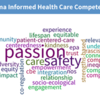
A newly established national group of experts known as TIHCER (pronounced “tīs-er”) recently convened for a first-time working meeting at The University of Oklahoma in Tulsa to advance the important cause of Trauma-Informed Health Care Education and Research. The gathering brought 26 members representing 10 states. This diverse group of experts comprise members from a variety of healthcare professions — medicine (physicians and residents/medical students), clinical psychology, psychiatry, social work, nursing science, public health, and others.
The TIHCER group began in January 2018 with only a few members meeting on conference calls and has now grown by word of mouth to over 50 members. During these conference calls, the need for collaboration among health care professionals became increasingly apparent as these experts shared and learned about the array of research and educational evidence-based approaches used all over the nation. One primary focus shared was the value and direction of students and clinicians becoming trauma-competent in their clinical practices.
At the Tulsa TIHCER conference, the discussions brought new insights and challenges, new ways of thinking, and provided more exposure to the different modalities used in medical educational settings across the country. The energy and dedication from the attendees are a shared common thread. Each member demonstrated their commitment to invest in and equip health care professionals to deliver proficient trauma-informed care. Along with building relationships and professional knowledge, rich discussions arose from the presentations delivered by members from prominent institutions, including George Washington University, Harvard University, Georgetown University, University of North Carolina, University of California at Davis, University at Buffalo, University of Wisconsin-Madison, and University of Illinois-Chicago.
On the first day of the 1½ day conference, a variety of teaching models were highlighted using various concepts and approaches that are either being considered or have been established into the healthcare environment. Some presentations covered topics such as models involving simulation experiences of the trauma-informed physical exam and primary care, e-modules for practitioner training, a newly published trauma-informed care textbook, current research over trauma-informed medical care, and the Trauma, Health Equity, and Neurobiology (THEN) curriculum. The final event of the first day brought a demonstration of the simulation-based training program at OU-Tulsa’s Tandy Simulation Center. The demonstration involved a role-play patient-medical student encounter that incorporated adverse childhood experiences (ACEs) into an ambulatory appointment with an adult established patient with chronic illness.
Following the demonstration, the members broke out into groups to discuss the experience, ask questions, and offer feedback. At the end of the day, a Q&A session followed where attendees were able to talk with a panel of experienced trainees (i.e., graduating residents). The panel shared their views of the ACEs simulation training and how their knowledge of trauma-informed care and ACEs impacted their view of patient care and barriers to becoming more trauma-informed competent.
Although limited to a shorter timeframe, the second day of the meeting was equally as packed as the first. Dr. Bob Block, former president of the American Academy of Pediatrics (AAP) and the Academy on Violence and Abuse (AVA), and Dr. Dave McCollum, cofounder of AVA, presented on historical perspectives of AVA and necessary competencies for addressing exposure to violence and abuse in patient care. Kevin Sherin (called in by video) serves on the committee on Prevention Practices for the American College of Preventive Medicine. He explained in his presentation the progress being made in his work group and the plan for an evidence-based ACPM:AJPM position statement on ACEs and resilience. He also discussed his group’s nomination to the Agency for Healthcare Research and Quality presented for consideration of development of an evidence-based guideline in ACEs trauma.
During the meeting, the attendees were asked to participate in a word cloud generated to capture keywords to target common themes during the discussions. The image below is an illustration of the important keywords brought up during the first day of the conference. Further feedback from the meeting suggested an excitement and a sense of progress from the attendees.
Here are some post-meeting comments by some of our experts:
“Having so many people and institutions starting to incorporate issues around trauma and TIC means we will continue to advance this effort in health care and it will continue to improve over time.”
“The OU-Tulsa simulations and trainee panel discussion were extremely worthwhile and provided excellent insight into TIC medical education!”
“My objectives changed after the meeting started. The need to have a good discussion was obvious. Seeing the progress being made by many people was energizing. In the end my objectives were well met.”

The group presented an outline of “next steps” from the discussions that circulated throughout the TIHCER meeting. The group plans to attend and ideally present at future conferences to showcase the rich information gathered from the Tulsa meeting. Working groups were established with expert volunteers lead in their areas of expertise. Some of these working groups include topics related to writing the TIHCER mission and values statements, seeking funding opportunities, involvement in scientific communication venues and presentations, developing competency/curricula strategies, and participating in evidence-based research addressing health outcomes and real-world effects of medical training on TIC and ACEs.
As TIHCER blazes the trail in “empowering health care professionals to deliver trauma informed care,” the group continues their efforts in creating coherent curriculum and competencies. The journey has just begun, and there is much work ahead.





Comments (0)